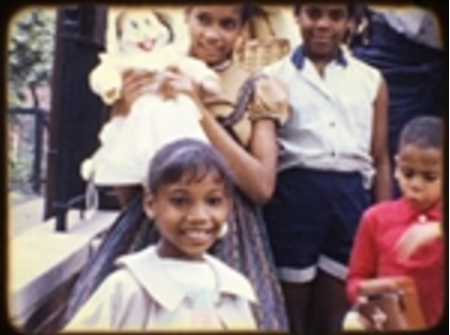
Courtesy of the Detroit Institute of Arts.
The DIA has begun exhibiting home movies made around 1967 to mark the 50th anniversary of that year's riots.
Home movies depicting crumbling buildings in the aftermath of the 1967 riots were among more than half a dozen on display at the Detroit Institute of Arts theater Thursday, as the museum kicked off a series of screenings that will run through the 50-year anniversary of the riots in late July.
The movies, shot between 1960 and 1969, depict life in a more segregated time, when the majority of city residents were white. White people are shown milling about the airport, cooling off in a Detroit public swimming pool and playing street wiffle ball alongside rows of small brick homes with manicured lawns. Black people are seen posing for wedding photos in a cramped living room, putting on a swimwear fashion show and skipping through the long-gone Boblo Island Amusement Park. The audience only once glimpsed whites and blacks intermingling, as the children of Henry Ford workers crab-walked and potato-sack-raced at the automaker's annual picnic.
"Back then there wasn't a lot of diversity," Lawrence Bohner said into a microphone as a film reel rolled silent footage of him splashing around a pool in 1960. "My wife and I, when we married ten years later, we wanted to make sure we lived in an area that was integrated."
Of course, the 75-minutes of footage offered more than just a window into the racial climate of the time; it gave viewers a chance to observe that 1960s aesthetic now relegated to tv shows and vintage stores. Cars were curvy and gleaming; women wore one-piece bathing suits that extended to their thighs; and Detroit's homes, buildings, sidewalks and parks were well-maintained.
That theme began to shift, however, after July of 1967.
"It was pretty incredible," contributor Michael Papin said as a projection of toppled bricks along Rosa Parks Blvd. in August of that year appeared. "Me as a 12-year-old watching this. It was just kind of surreal driving down part of Detroit and seeing these buildings."
Nearly 1,400 buildings were burned over the course of four-days of rioting. Forty-three people were killed and more than 300 were injured. Though the disturbance began when a raid on an unlicensed after-hours bar turned violent, the uprising was fueled by more than that. Reports of police brutality and underlying conditions including segregated housing and schools also played a role.
The DIA will hold 16 more riot-era home video screenings through July 29, the week of the 50th anniversary of the riots. More information is available on the DIA website.

